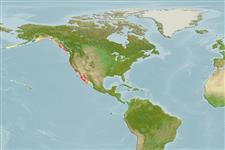Common names from other countries
>
Eupercaria/misc (Various families in series Eupercaria) >
Sciaenidae (Drums or croakers)
Etymology: Atractoscion: Greek, atraktos, arrow + Greek, skion, skiaina = barbel, red mullet (Ref. 45335).
More on author: Ayres.
Environment: milieu / climate zone / depth range / distribution range
Écologie
marin démersal; profondeur 0 - 122 m (Ref. 2850). Subtropical; 65°N - 22°N
Eastern Pacific: Alaska to southern Baja California, Mexico and the Gulf of California.
Taille / Poids / Âge
Maturity: Lm ? range ? - ? cm
Max length : 166 cm TL mâle / non sexé; (Ref. 40637); common length : 100.0 cm TL mâle / non sexé; (Ref. 9118); poids max. publié: 41.0 kg (Ref. 2850); âge max. reporté: 20 années (Ref. 56049)
Épines dorsales (Total): 10 - 11; Rayons mous dorsaux (Total): 20-23; Épines anales 2; Rayons mous anaux: 8 - 9; Vertèbres: 24. Pelvic fins with fleshy appendage at base.
Often in schools over rocky bottom and in kelp beds (Ref. 2850). Also found in the surf zone (Ref. 2850). Young in bays and along sandy beaches (Ref. 2850). Feed on fishes, squids, and crayfish (Ref. 6885). Pelagic spawners (Ref. 56049). Excellent food fish (Ref. 9118).
Pelagic spawner (Ref. 56049).
Eschmeyer, W.N., E.S. Herald and H. Hammann, 1983. A field guide to Pacific coast fishes of North America. Boston (MA, USA): Houghton Mifflin Company. xii+336 p. (Ref. 2850)
Statut dans la liste rouge de l'IUCN (Ref. 130435)
CITES (Ref. 128078)
Not Evaluated
Menace pour l'homme
Harmless
Utilisations par l'homme
Pêcheries: intérêt commercial mineur; pêche sportive: oui
Plus d'informations
RéférencesAquacultureProfil d'aquacultureSouchesGénétiqueElectrophoresesHéritabilitéPathologiesTraitementMass conversion
CollaborateursImagesStamps, Coins Misc.SonsCiguateraVitesseType de nageSurface branchialeOtolithesCerveauxVision
Outils
Articles particuliers
Télécharger en XML
Sources Internet
Estimates based on models
Preferred temperature (Ref.
115969): 9 - 22.9, mean 12.8 (based on 76 cells).
Phylogenetic diversity index (Ref.
82804): PD
50 = 0.5312 [Uniqueness, from 0.5 = low to 2.0 = high].
Bayesian length-weight: a=0.00794 (0.00404 - 0.01563), b=3.07 (2.91 - 3.23), in cm Total Length, based on LWR estimates for this species & (Sub)family-body (Ref.
93245).
Niveau trophique (Ref.
69278): 4.3 ±0.70 se; based on food items.
Résilience (Ref.
120179): Faible, temps minimum de doublement de population : 4,5 à 14 années (K=0.13; tm=4; tmax=20).
Fishing Vulnerability (Ref.
59153): High to very high vulnerability (70 of 100).
Climate Vulnerability (Ref.
125649): Moderate to high vulnerability (48 of 100).
